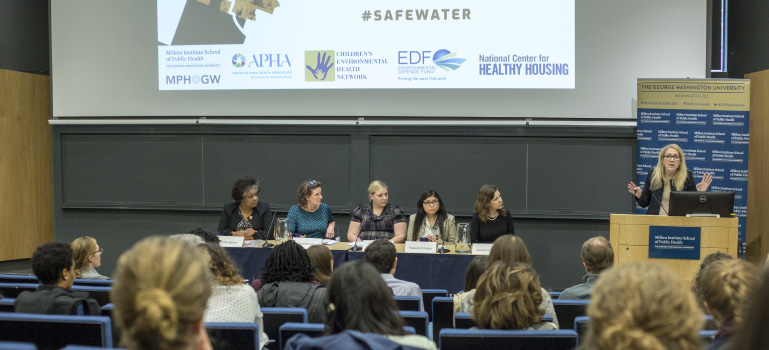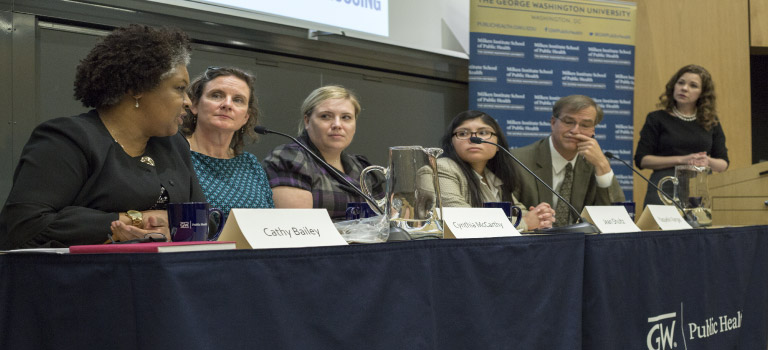Flint Was a Wake Up Call. Now What? Framing the Conversation around Lead, Water and Public Health

WASHINGTON —In late 2014, Yaquelin Vargas became suspicious something was wrong with the water in her hometown of Flint, Mich. She was getting rashes and losing her hair. The shower water felt “like a gooey gel” on her skin. Soon after, she found out that she was pregnant.
“I didn’t want to live like that anymore,” Vargas said January 24 at a panel hosted at the Milken Institute School of Public Health at the George Washington University. “But nobody was listening.”
Vargas was one of many voices sounding the alarm about the water in Flint four years ago.
Lead is a neurotoxin and its consumption can cause developmental disorders and brain damage. No amount of lead in humans is considered safe. Nevertheless, city officials had insisted the water was safe for months before a study confirmed highly elevated blood lead levels in the city’s children.
After Vargas’ baby was born she began breast-feeding, unaware she was passing lead into her child’s system.
When she finally learned about the dangerous levels of lead in the city’s water, “I felt like I had poisoned my own daughter,” she said during the panel discussion, with her daughter in the audience. “By the time they finally confirmed that something was wrong with the water, mothers like me and the rest of the community felt so angry. We knew it was time to reach even more people.”

The “Drinking Water and Lead Service Lines” panel focused on the health risks of lead service lines within the broader context of tackling all sources of lead and the role of public health professionals in the replacement process. The event was organized by American Public Health Association, the Children’s Environmental Health Network, the National Center for Healthy Housing and the Environmental Defense Fund, and brought together officials from public health agencies, water utilities and other stakeholders to discuss creative solutions to eradicate lead from drinking water.
“I have seen remarkable transformations in this field,” said Lynn Goldman, Michael and Lori Milken Dean of the Milken Institute School of Public Health. “But what we’ve learned from Flint is that we need to look at our policies and think holistically on a solution.”
Flint isn’t the only place in the country where elevated lead levels are a public health problem. Nationwide, old lead service lines connect an estimated 6 million to 10 million homes and businesses to community drinking water mains. A 2016 Reuters report revealed children in almost 3,000 communities across America had elevated lead levels in their blood.
Lead-based paint is still the most common source of lead exposure but Amanda Reddy, executive director of the National Center for Healthy Housing, said public health officials need to start looking at lead exposure “more holistically.”
“The Flint situation has taught a lot of us in the public health community to think differently,” Reddy said.
Tom Neltner, the chemicals policy director at the Environmental Defense Fund, said lead sources should be more thoroughly researched across the public health community.
In the past “we assumed [lead exposure] was all from lead paint,” he said. “We have learned the hard way that water is a source of lead exposure and there are other sources as well. Now that we know, we can do better to serve the community.”
“It starts with policy at the highest level and also filters down to the local level.”
The panelists discussed one such effort: the Lead Service Line Replacement Collaborative a group of 25 national organizations pushing to replace lead service lines — the largest source of lead in drinking water — across the country.
“We need to make the replacement of service lines and water mains affordable for homeowners and the overall community,” said Cathy Bailey, executive director of the Greater Cincinnati Water Works. “As the water utility, we started the conversation in our city because we had a big stake and we realized that we couldn’t do it alone.”
Panel participants also said the 1991 Lead and Copper Rule, which dictates how communities test for lead in drinking water, has not been revised in more than a decade and needs to be updated.
“It starts with policy at the highest level and also filters down to the local level,” said Jean Shultz, environmental and disease control specialist at the Milwaukee Department of Public Health.
The panelists agreed Flint was a wake-up call to the public health community, and discussed how to continue tackling the issue together.
“Public pressure put Flint in the spotlight, and it made a difference [because] now we’re all talking about it,” said Nsedu Witherspoon, executive director of the Children’s Environmental Health Network. “But there was also a missed opportunity. Going forward, how do we address the lead exposure in a meaningful way? Hopefully, 10 years from now we won’t be having this discussion.”
If you weren’t able attend the panel in person or via livestream, check out a recording of the event here.
Citation for this content: MPH@GW, the online MPH program from the Milken Institute School of Public Health at the George Washington University


